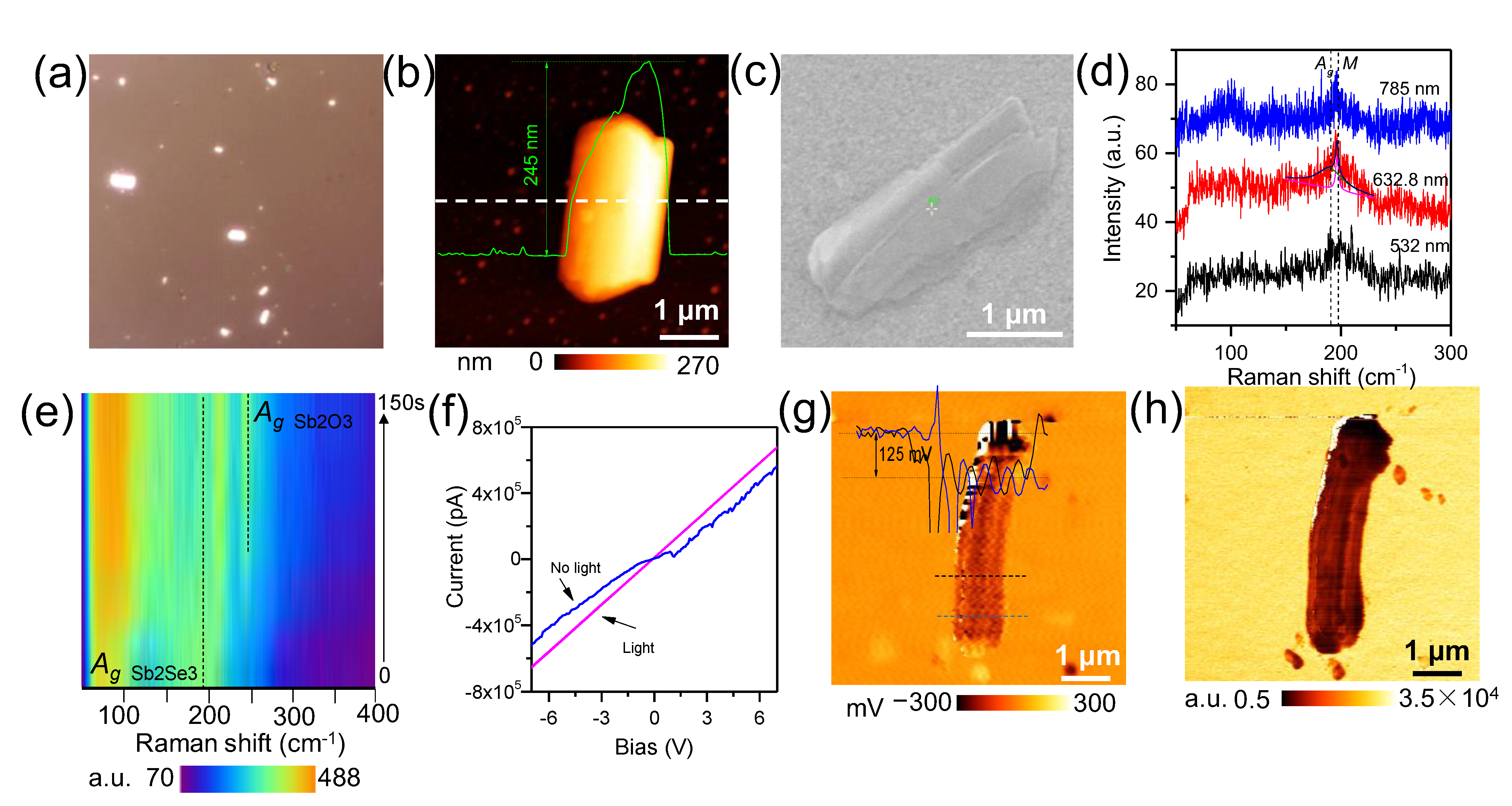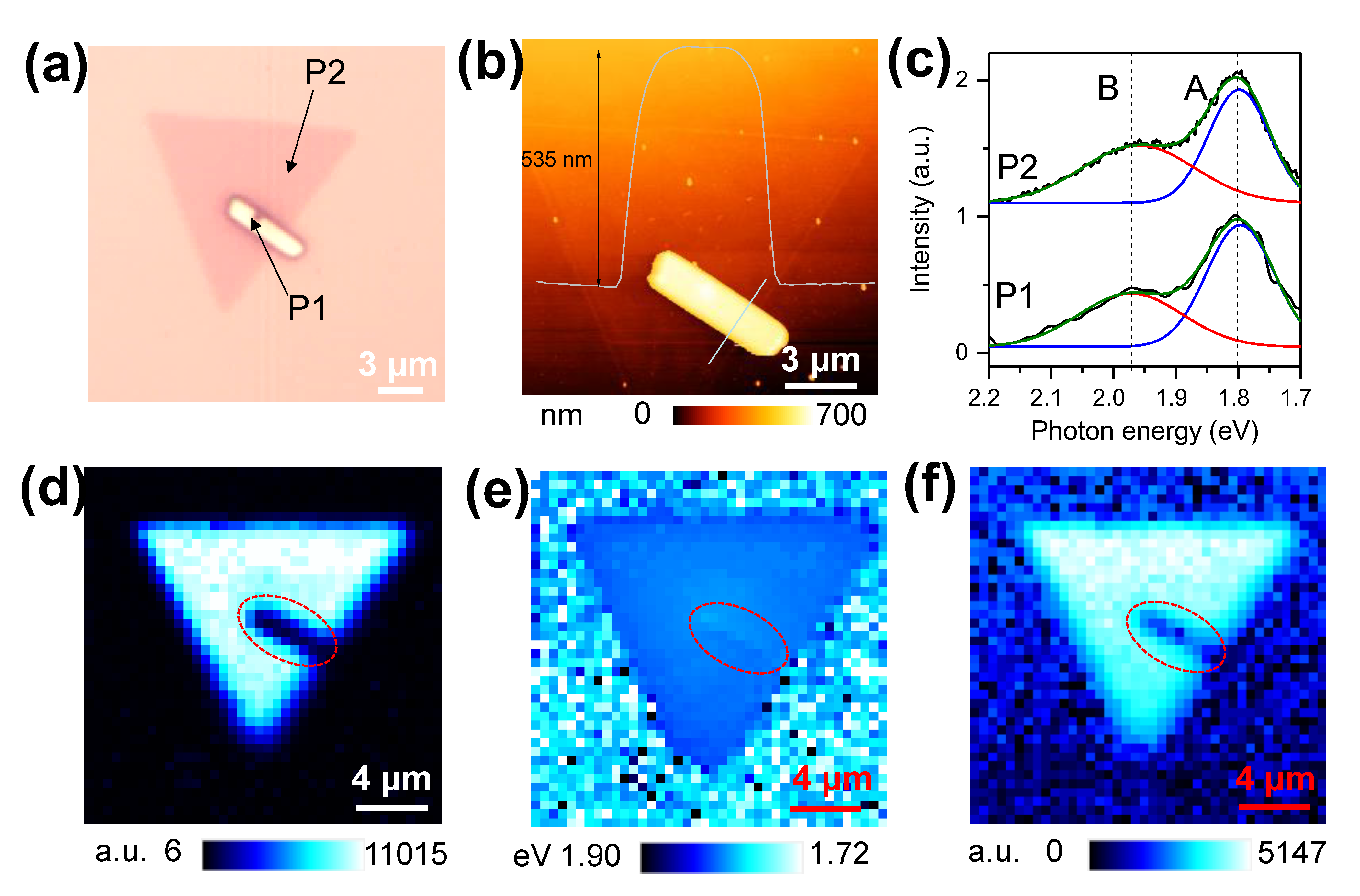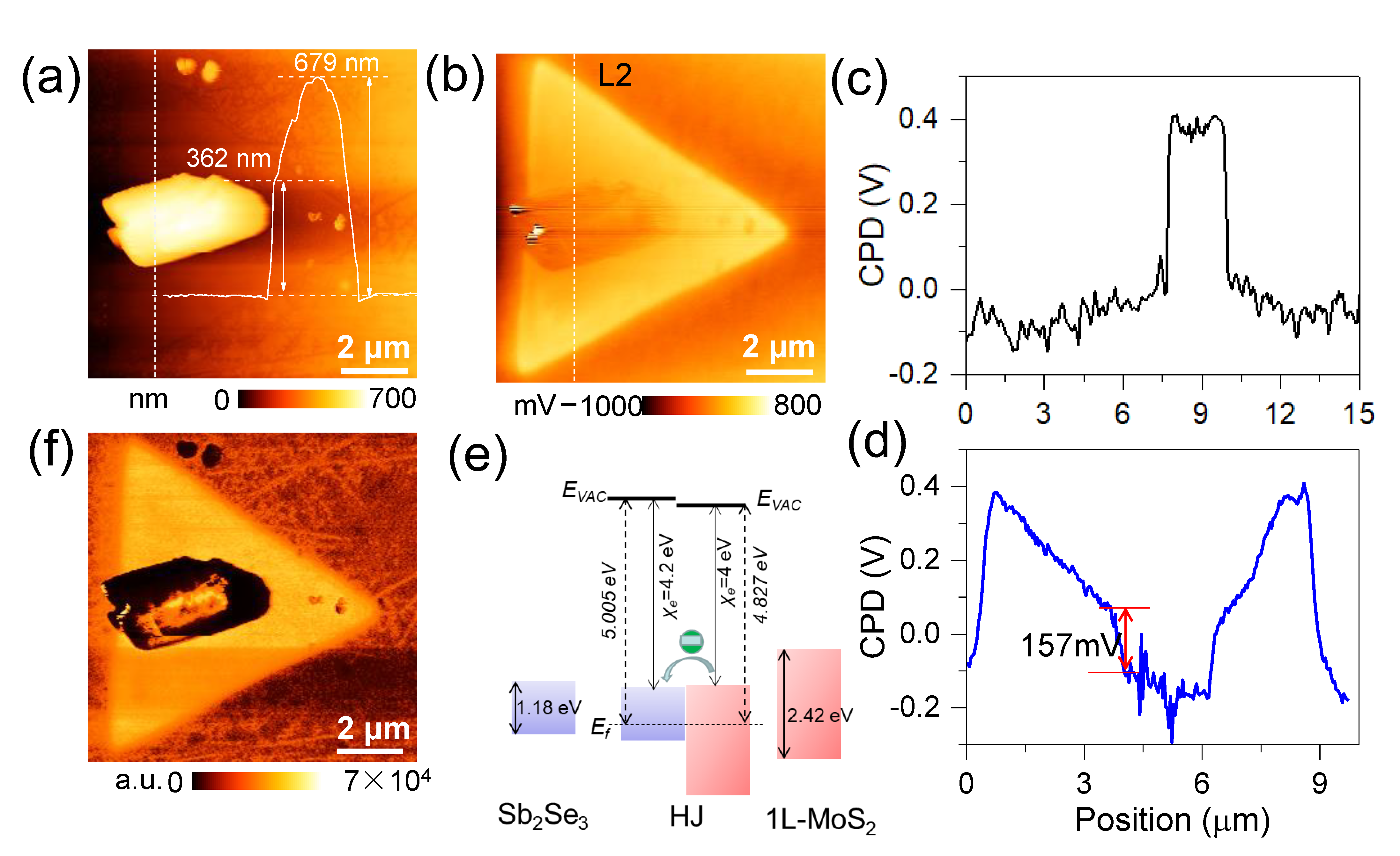Preparation and Charge Transfer at Sb2Se3/1L-MoS2 Heterojunction
Abstract
:1. Introduction
2. Experiment and Characterization
3. Results and Discussions
Supplementary Materials
Author Contributions
Funding
Data Availability Statement
Conflicts of Interest
References
- Yu, Y.; Hu, S.; Su, L.; Huang, L.; Liu, Y.; Jin, Z.; Purezky, A.A.; Geohegan, D.B.; Kim, K.W.; Zhang, Y. Equally efficient interlayer exciton relaxation and improved absorption in epitaxial and non-epitaxial MoS2/WS2 heterostructures. Nano Lett. 2015, 15, 486–491. [Google Scholar] [CrossRef] [PubMed]
- Furchi, M.M.; Pospischil, A.; Libisch, F.; Burgdörfer, J.; Mueller, T. Photovoltaic effect in an electrically tunable van der Waals heterojunction. Nano Lett. 2014, 14, 4785. [Google Scholar] [CrossRef] [PubMed]
- Lee, C.H.; Lee, G.H.; Zande, A.M.V.D.; Chen, W.; Li, Y.; Han, M.; Cui, X.; Arefe, G.; Nuckolls, C.; Heinz, T.F. Atomically thin p–n junctions with van der Waals heterointerfaces. Nat. Nanotechnol. 2014, 9, 676. [Google Scholar] [CrossRef] [PubMed]
- Hong, X.; Kim, J.; Shi, S.-F.; Zhang, Y.; Jin, C.; Sun, Y.; Tongay, S.; Wu, J.; Zhang, Y.; Wang, F. Ultrafast charge transfer in atomically thin MoS2/WS2 heterostructures. Nat. Nanotechnol. 2014, 9, 682. [Google Scholar] [CrossRef]
- Chen, F.; Su, W.; Ding, S.; Fu, L. The fabrication and tunable optical properties of 2D transition metal dichalcogenides heterostructures by adjusting the thickness of Mo/W films. Appl. Surf. Sci. 2020, 505, 144192. [Google Scholar] [CrossRef]
- Dean, C.R.; Young, A.F.; Meric, I.; Lee, C.; Wang, L.; Sorgenfrei, S.; Watanabe, K.; Taniguchi, T.; Kim, P.; Shepard, K.L. Boron nitride substrates for high-quality graphene electronics. Nat. Nanotechnol. 2010, 5, 722–726. [Google Scholar] [CrossRef]
- Baranowski, M.; Surrente, A.; Klopotowski, L.; Urban, J.; Plochocka, P. Probing the interlayer exciton physics in a MoS2/MoSe2/MoS2 van der Waals heterostructure. Nano Lett. 2018, 17, 6360. [Google Scholar] [CrossRef]
- Cao, L.; Zhong, J.; Yu, J.; Zeng, C.; Ding, J.; Cong, C.; Yue, X.; Liu, Z.; Liu, Y. Valley-polarized local excitons in WSe 2/WS2 vertical heterostructures. Opt. Express 2020, 28, 22135–22143. [Google Scholar] [CrossRef]
- Carozo, V.; Fujisawa, K.; Rao, R.; Kahn, E.; Cunha, J.R.; Zhang, T.; Rubin, D.; Salazar, M.F.; de Luna Bugallo, A.; Kar, S. Excitonic processes in atomically-thin MoSe2/MoS2 vertical heterostructures. 2d Mater. 2018, 5, 031016. [Google Scholar] [CrossRef]
- Ding, Y.; Zhou, N.; Gan, L.; Yan, X.; Wu, R.; Abidi, I.H.; Waleed, A.; Pan, J.; Ou, X.; Zhang, Q. Stacking-mode confined growth of 2H-MoTe2 /MoS2 bilayer heterostructures for UV-vis-IR photodetectors. Nano Energy 2018, 49, 200–208. [Google Scholar] [CrossRef]
- Fu, Q.; Wang, X.; Zhou, J.; Xia, J.; Zeng, Q.; Lv, D.; Zhu, C.; Wang, X.; Shen, Y.; Li, X. One-step synthesis of metal/semiconductor heterostructure NbS2/MoS2. Chem. Mater. 2018, 30, 4001–4007. [Google Scholar] [CrossRef]
- Gong, Y.; Lei, S.; Ye, G.; Li, B.; He, Y.; Keyshar, K.; Zhang, X.; Wang, Q.; Lou, J.; Liu, Z. Two-step growth of two-dimensional WSe2/MoSe2 heterostructures. Nano Lett. 2015, 15, 6135–6141. [Google Scholar] [CrossRef] [PubMed]
- Irisawa, T.; Okada, N.; Chang, W.-H.; Okada, M.; Mori, T.; Endo, T.; Miyata, Y. CVD grown bilayer WSe2/MoSe2 heterostructures for high performance tunnel transistors. Jpn. J. Appl. Phys. 2020, 59, SGGH05. [Google Scholar] [CrossRef]
- Li, F.; Feng, Y.; Li, Z.; Ma, C.; Qu, J.; Wu, X.; Li, D.; Zhang, X.; Yang, T.; He, Y. Rational kinetics control toward universal growth of 2D vertically stacked heterostructures. Adv. Mater. 2019, 31, 1901351. [Google Scholar] [CrossRef] [PubMed]
- Nikam, R.D.; Sonawane, P.A.; Sankar, R.; Chen, Y.-T. Epitaxial growth of vertically stacked p-MoS2/n-MoS2 heterostructures by chemical vapor deposition for light emitting devices. Nano Energy 2017, 32, 454–462. [Google Scholar] [CrossRef]
- Vidal-Fuentes, P.; Guc, M.; Alcobe, X.; Jawhari, T.; Placidi, M.; Pérez-Rodríguez, A.; Saucedo, E.; Roca, V.I. Multiwavelength excitation Raman scattering study of Sb2 Se3 compound: Fundamental vibrational properties and secondary phases detection. 2d Mater. 2019, 6, 045054. [Google Scholar] [CrossRef]
- Wan, Y.; Huang, J.-K.; Chuu, C.-P.; Hsu, W.-T.; Lee, C.-J.; Aljarb, A.; Huang, C.-W.; Chiu, M.-H.; Tang, H.-L.; Lin, C. Strain-directed layer-by-layer epitaxy toward van der Waals homo-and heterostructures. ACS Mater. Lett. 2021, 3, 442–453. [Google Scholar] [CrossRef]
- Wu, X.; Wang, X.; Li, H.; Zeng, Z.; Zheng, B.; Zhang, D.; Li, F.; Zhu, X.; Jiang, Y.; Pan, A. Vapor growth of WSe2/WS2 heterostructures with stacking dependent optical properties. Nano Res. 2019, 12, 3123–3128. [Google Scholar] [CrossRef]
- Xia, J.; Yan, J.; Wang, Z.; He, Y.; Gong, Y.; Chen, W.; Sum, T.C.; Liu, Z.; Ajayan, P.M.; Shen, Z. Strong coupling and pressure engineering in WSe2–MoSe2 heterobilayers. Nat. Phys. 2021, 17, 92–98. [Google Scholar] [CrossRef]
- Yuan, J.; Sun, T.; Hu, Z.; Yu, W.; Ma, W.; Zhang, K.; Sun, B.; Lau, S.P.; Bao, Q.; Lin, S. Wafer-scale fabrication of two-dimensional PtS2/PtSe2 heterojunctions for efficient and broad band photodetection. ACS Appl. Mater. Interfaces 2018, 10, 40614–40622. [Google Scholar] [CrossRef]
- Yuan, L.; Zheng, B.; Kunstmann, J.; Brumme, T.; Kuc, A.B.; Ma, C.; Deng, S.; Blach, D.; Pan, A.; Huang, L. Twist-angle-dependent interlayer exciton diffusion in WS2–WSe2 heterobilayers. Nat. Mater. 2020, 19, 617–623. [Google Scholar] [CrossRef] [PubMed]
- Zhai, X.; Xu, X.; Peng, J.; Jing, F.; Zhang, Q.; Liu, H.; Hu, Z. Enhanced optoelectronic performance of CVD-grown metal–semiconductor NiTe2/MoS2 heterostructures. ACS Appl. Mater. Interfaces 2020, 12, 24093–24101. [Google Scholar] [CrossRef] [PubMed]
- Zhang, C.; Chuu, C.-P.; Ren, X.; Li, M.-Y.; Li, L.-J.; Jin, C.; Chou, M.-Y.; Shih, C.-K. Interlayer couplings, Moiré patterns, and 2D electronic superlattices in MoS2/WSe2 hetero-bilayers. Sci. Adv. 2017, 3, e1601459. [Google Scholar] [CrossRef] [PubMed]
- Zhang, P.; Bian, C.; Ye, J.; Cheng, N.; Wang, X.; Jiang, H.; Wei, Y.; Zhang, Y.; Du, Y.; Bao, L. Epitaxial growth of metal-semiconductor van der Waals heterostructures NbS2/MoS2 with enhanced performance of transistors and photodetectors. Sci. China Mater. 2020, 63, 1548–1559. [Google Scholar] [CrossRef]
- Zhang, X.; Xiao, S.; Nan, H.; Mo, H.; Wan, X.; Gu, X.; Ostrikov, K.K. Controllable one-step growth of bilayer MoS2–WS2/WS2 heterostructures by chemical vapor deposition. Nanotechnology 2018, 29, 455707. [Google Scholar] [CrossRef] [PubMed]
- Zhou, J.; Kong, X.; Sekhar, M.C.; Lin, J.; Le Goualher, F.; Xu, R.; Wang, X.; Chen, Y.; Zhou, Y.; Zhu, C. Epitaxial synthesis of monolayer PtSe2 single crystal on MoSe2 with strong interlayer coupling. ACS Nano 2019, 13, 10929–10938. [Google Scholar] [CrossRef]
- Miller, B.; Steinhoff, A.; Pano, B.; Klein, J.; Jahnke, F.; Holleitner, A.; Wurstbauer, U. Long-lived direct and indirect interlayer excitons in van der Waals heterostructures. Nano Lett. 2017, 17, 5229–5237. [Google Scholar] [CrossRef]
- Birkett, M.; Linhart, W.M.; Stoner, J.; Phillips, L.J.; Durose, K.; Alaria, J.; Major, J.D.; Kudrawiec, R.; Veal, T.D. Band gap temperature-dependence of close-space sublimation grown Sb2Se3 by photo-reflectance. APL Mater. 2018, 6, 084901. [Google Scholar] [CrossRef]
- Chen, C.; Bobela, D.C.; Yang, Y.; Lu, S.; Zeng, K.; Ge, C.; Yang, B.; Gao, L.; Zhao, Y.; Beard, M.C.; et al. Characterization of basic physical properties of Sb2Se3 and its relevance for photovoltaics. Front. Optoelectron. 2017, 10, 18–30. [Google Scholar] [CrossRef]
- Chen, S.; Ishaq, M.; Xiong, W.; Ali Shah, U.; Farooq, U.; Luo, J.; Zheng, Z.; Su, Z.; Fan, P.; Zhang, X.; et al. Improved open-circuit voltage of Sb2Se3 thin-film solar cells via interfacial sulfur diffusion-induced gradient bandgap engineering. Solar RRL 2021, 5, 2100419. [Google Scholar] [CrossRef]
- Guo, L.; Zhang, B.; Li, S.; Montgomery, A.; Li, L.; Xing, G.; Zhang, Q.; Qian, X.; Yan, F. Interfacial engineering of oxygenated chemical bath–deposited CdS window layer for highly efficient Sb2Se3 thin-film solar cells. Mater. Today Phys. 2019, 10, 100125. [Google Scholar] [CrossRef]
- Li, G.; Li, Z.; Liang, X.; Guo, C.; Shen, K.; Mai, Y. Improvement in Sb2Se3 solar cell efficiency through band alignment engineering at the buffer/absorber interface. ACS Appl. Mater. Interfaces 2019, 11, 828–834. [Google Scholar] [CrossRef] [PubMed]
- Wang, L.; Li, D.-B.; Li, K.; Chen, C.; Deng, H.-X.; Gao, L.; Zhao, Y.; Jiang, F.; Li, L.; Huang, F.; et al. STable 6%-efficient Sb2Se3 solar cells with a ZnO buffer layer. Nat. Energy 2017, 2, 17046. [Google Scholar] [CrossRef]
- Chen, C.; Zhao, Y.; Lu, S.; Li, K.; Li, Y.; Yang, B.; Chen, W.; Wang, L.; Li, D.; Deng, H.; et al. Accelerated optimization of TiO2/Sb2Se3 thinfilm solar cells by high-throughput combinatorial approach. Adv. Energy Mater. 2017, 7, 1700866. [Google Scholar] [CrossRef]
- Wang, J.; Rehman, S.U.; Xu, Y.; Zuo, B.; Cheng, H.; Guo, L.; Zou, B.; Zhang, X.; Li, C. Two-dimensional antimony selenide (Sb2Se3) nanosheets prepared by hydrothermal method for visible-light photodetectors. Sol. Energy 2022, 233, 213–220. [Google Scholar] [CrossRef]
- Song, H.; Li, T.; Zhang, J.; Zhou, Y.; Luo, J.; Chen, C.; Yang, B.; Ge, C.; Wu, Y.; Tang, J. Highly anisotropic Sb2Se3 nanosheets: Gentle exfoliation from the bulk precursors possessing 1D crystal structure. Adv. Mater. 2017, 29, 1700441. [Google Scholar] [CrossRef]
- Zhao, M.; Su, J.; Zhao, Y.; Luo, P.; Wang, F.; Han, W.; Li, Y.; Zu, X.; Qiao, L.; Zhai, T. Sodium-mediated epitaxial growth of 2D ultrathin Sb2Se3 flakes for broadband photodetection. Adv. Funct. Mater. 2020, 30, 1909849. [Google Scholar] [CrossRef]
- Sun, G.; Li, B.; Li, J.; Zhang, Z.; Ma, H.; Chen, P.; Zhao, B.; Wu, R.; Dang, W.; Yang, X.; et al. Direct van der Waals epitaxial growth of 1D/2D Sb2Se3/WS2 mixed-dimensional p-n heterojunctions. Nano Res. 2019, 12, 1139–1145. [Google Scholar] [CrossRef]
- Valdman, L.; Wen, X.; Lu, Z.; Chen, X.; Hiebel, F.; Zhang, L.; Kisslinger, K.; Tao, Y.; Washington, M.; Lu, T.-M.; et al. Surface and interface structures of epitaxial Sb2Se3 on mica. Appl. Surf. Sci. 2021, 567, 150859. [Google Scholar] [CrossRef]
- Shongalova, A.; Correia, M.R.; Vermang, B.; Cunha, J.M.V.; Salomé, P.M.P.; Fernandes, P.A. On the identification of Sb2Se3 using Raman scattering. MRS Commun. 2018, 8, 865–870. [Google Scholar] [CrossRef]
- Han, W.; Huang, P.; Li, L.; Wang, F.; Zhai, T. Two-dimensional inorganic molecular crystals. Nat. Commun. 2019, 10, 4728. [Google Scholar] [CrossRef] [PubMed]
- Smithe, K.K.H.; Krayev, A.V.; Bailey, C.S.; Lee, H.R.; Yalon, E.; Aslan, Ö.B.; Muñoz Rojo, M.; Krylyuk, S.; Taheri, P.; Davydov, A.V.; et al. Nanoscale heterogeneities in monolayer MoSe2 revealed by correlated scanning probe microscopy and tip-enhanced Raman spectroscopy. ACS Appl. Nano Mater. 2018, 1, 572–579. [Google Scholar] [CrossRef]
- Mamta; Maurya, K.K.; Singh, V.N. Enhancing the performance of an Sb2Se3-based solar cell by dual buffer layer. Sustainability 2021, 13, 12320. [Google Scholar] [CrossRef]
- Su, W.; Jin, L.; Qu, X.; Huo, D.; Yang, L. Defect passivation induced strong photoluminescence enhancement of rhombic monolayer MoS2. Phys. Chem. Chem. Phys. 2016, 18, 14001–14006. [Google Scholar] [CrossRef]
- Molina-Sanchez, A.; Wirtz, L. Phonons in single-layer and few-layer MoS2 and WS2. Phys. Rev. B 2011, 84, 155413. [Google Scholar] [CrossRef]
- Li, F.; Yan, Y.; Han, B.; Li, L.; Huang, X.; Yao, M.; Gong, Y.; Jin, X.; Liu, B.; Zhu, C.; et al. Pressure confinement effect in MoS2 monolayers. Nanoscale 2015, 7, 9075–9082. [Google Scholar] [CrossRef] [PubMed]
- Mak, K.F.; Lee, C.; Hone, J.; Shan, J.; Heinz, T.F. Atomically thin moS2: A new direct-gap semiconductor. Phys. Rev. Lett. 2010, 105, 136805. [Google Scholar] [CrossRef]
- Lee, S.Y.; Kim, U.J.; Chung, J.; Nam, H.; Jeong, H.Y.; Han, G.H.; Kim, H.; Oh, H.M.; Lee, H.; Kim, H.; et al. Large work function modulation of monolayer MoS2 by ambient gases. ACS Nano 2016, 10, 6100–6107. [Google Scholar] [CrossRef]
- Hill, H.M.; Rigosi, A.F.; Roquelet, C.; Chernikov, A.; Berkelbach, T.C.; Reichman, D.R.; Hybertsen, M.S.; Brus, L.E.; Heinz, T.F. Observation of excitonic Rydberg states in monolayer MoS2 and WS2 by photoluminescence excitation spectroscopy. Nano Lett. 2015, 15, 2992–2997. [Google Scholar] [CrossRef]
- Tosun, M.; Fu, D.; Desai, S.B.; Ko, C.; Seuk Kang, J.; Lien, D.-H.; Najmzadeh, M.; Tongay, S.; Wu, J.; Javey, A. MoS2 heterojunctions by thickness modulation. Sci. Rep. 2015, 5, 10990. [Google Scholar] [CrossRef]
- Cao, Y.; Zhu, X.-Y.; Chen, H.-B.; Wang, C.-G.; Zhang, X.-T.; Hou, B.-D.; Shen, M.-R.; Zhou, J. Simulation and optimal design of antimony selenide thin film solar cells. Acta Phys. Sin. 2018, 67, 247301. [Google Scholar] [CrossRef]
- Su, W.; Kumar, N.; Shu, H.; Lancry, O.; Chaigneau, M. In situ visualization of optoelectronic behavior of grain boundaries in monolayer WSe2 at the nanoscale. J. Phys. Chem. C 2021, 125, 26883–26891. [Google Scholar] [CrossRef]




Publisher’s Note: MDPI stays neutral with regard to jurisdictional claims in published maps and institutional affiliations. |
© 2022 by the authors. Licensee MDPI, Basel, Switzerland. This article is an open access article distributed under the terms and conditions of the Creative Commons Attribution (CC BY) license (https://creativecommons.org/licenses/by/4.0/).
Share and Cite
Wang, Y.; Su, W.; Chen, F.; Lu, H.-W. Preparation and Charge Transfer at Sb2Se3/1L-MoS2 Heterojunction. Electronics 2022, 11, 2574. https://doi.org/10.3390/electronics11162574
Wang Y, Su W, Chen F, Lu H-W. Preparation and Charge Transfer at Sb2Se3/1L-MoS2 Heterojunction. Electronics. 2022; 11(16):2574. https://doi.org/10.3390/electronics11162574
Chicago/Turabian StyleWang, Yiren, Weitao Su, Fei Chen, and Hong-Wei Lu. 2022. "Preparation and Charge Transfer at Sb2Se3/1L-MoS2 Heterojunction" Electronics 11, no. 16: 2574. https://doi.org/10.3390/electronics11162574
APA StyleWang, Y., Su, W., Chen, F., & Lu, H.-W. (2022). Preparation and Charge Transfer at Sb2Se3/1L-MoS2 Heterojunction. Electronics, 11(16), 2574. https://doi.org/10.3390/electronics11162574





